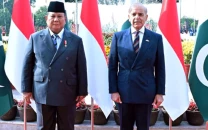If Pakistan's economy grows over 3.8%, it can trigger imbalances
ADB research paper says country needs to fix existing structural economic issues

Stagnating value of exports since 2012 and slowing remittance growth since 2014 are likely to further shift the BOP equilibrium growth rate downwards from 3.8%. PHOTO: FILE
In order to avoid the next balance of payments crisis, Pakistan will have to fix its exports and reduce dependency on imports, according to the working paper, “Why Pakistan’s economic growth continues to be balance of payments constrained,” written by the ADB’s two economists Kristian Rosbach and Lilia Aleksanyan.
“In the current structural and product specialisation circumstances, if Pakistan’s economy is to grow faster than 3.8% in the medium-term, external imbalances will occur,” according to the finding of the authors.
ADB keeps Pakistan’s growth forecast unchanged at 2.8%
This paper estimates a long-term structural BOP-constrained GDP growth rate of 3.77% for the period 1980-2017. At 4.89%, the average GDP growth rate for that period is higher than the BOP equilibrium GDP growth rate. Periods of GDP growth rates that are higher than the BOP-constrained growth rate tend to result in foreign exchange reserve depletion, followed by periods of fiscal and monetary policy-led suppressed growth.
After witnessing 2013-18 period of high economic growth, Pakistan again faced balance of payments crisis, which forced the government of Prime Minister Imran Khan to sign a tough International Monetary Fund (IMF) deal that suffocated economic growth and is now causing increase in poverty and unemployment.
The working paper underlined that stagnating value of exports since 2012 and slowing remittance growth since 2014 are likely further shifting the BOP equilibrium growth rate downwards from the 3.8%.
In the past, macroeconomic measures to reverse foreign reserve outflows often resulted in slowing economic growth.
Last year, Pakistan recorded a low economic growth rate of 3.3%, which the finance ministry has expected to further slowdown to 2.4% in this fiscal year. However, any growth rate that is below 5% to 6% increases unemployment in Pakistan, according to independent Pakistani economists.
The ADB paper noted that since end-2017, the government implemented a number of economic reforms to address the BOP crisis, including regulatory measures, reduced imports, increased interest rates, and depreciation of the exchange rate to the US dollar by almost 33%.
“In spite of significant currency depreciation, merchandise exports declined by 2.2%, between fiscal year 2017-18 and fiscal year 2018-19,” according to the paper.
Rising debt hinders Pakistan’s growth
On average, over the last decade, Pakistan has lost global market share by 1.45% per annum, with foreign exchange reserves further declining from $9.8 billion at the end of FY2018 to $7.3 billion at the end of FY2019, only enough to finance about 1.4 months of imports.
“Improving Pakistan’s export performance remains the most relevant long-term structural challenge to alleviate the balance-of-payments constraint to sustained economic growth,” according to the paper.
Pakistan’s export performance has been weak for decades. Since 2010, export growth has been largely stagnant, with a growing average trade deficit. Pakistan’s exports continue to lose market shares due to the growing proportion of unsophisticated export goods.
Gaps in Pakistan’s trade balance are structural, emerging whenever domestic demand grows too fast. Raising Pakistan’s economic growth rate in a way that remains consistent with BOP equilibrium would require reforms that would help its industries produce export products that are more attractive to external markets, as well as reducing the income elasticity of imports, recommended the authors.
Pakistan’s import-competing industries should become more competitive, and the energy mix should be altered to become less reliant on oil imports, they added.
Pakistan’s industry needs to diversify and help reduce the economy’s dependence on imports. A more diversified economy results in more diverse exports, and this is required to acquire the wider set of productive capabilities that is needed to export goods with a higher level of sophistication.
The first steps toward export diversification could be to identify the causes of lost export value in important industries and explore options for moving into new export products that require productive capabilities similar to those used for existing Pakistani exports but have a higher level of sophistication within the product space.
There was also a need to generate an environment conducive for exports (terms of trade, export insurance, export promotion, and trade agreements, according to the ADB. The ADB has also recommended improving the availability of trade finance.
To implement these steps, it is required that policy design, coordination, and implementation facilitate private sector attempts to acquire capabilities in latent and more sophisticated products, as well as encourage meaningful strategies to develop new capabilities in distant products.
The composition of imports contributes to the BOP constraint, according to the findings. Around 40% of electricity production in Pakistan is oil-based, and 25% is gas-based. Direct and indirect subsidies for the energy sector are incentivising oil consumption, thus driving imports.
Published in The Express Tribune, December 19th, 2019.
Like Business on Facebook, follow @TribuneBiz on Twitter to stay informed and join in the conversation.



















COMMENTS
Comments are moderated and generally will be posted if they are on-topic and not abusive.
For more information, please see our Comments FAQ